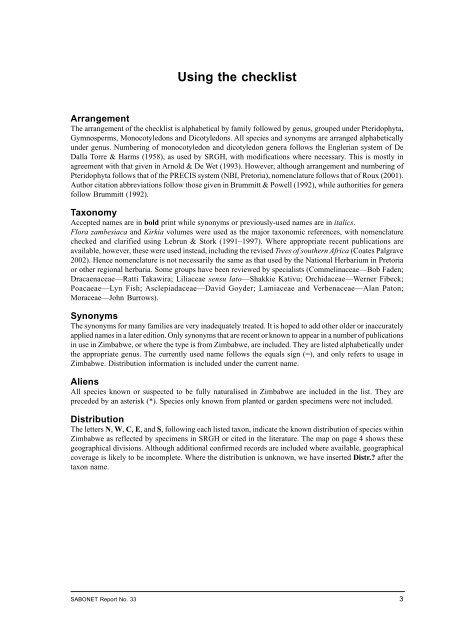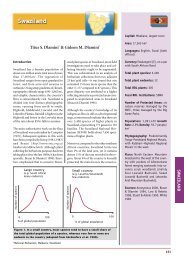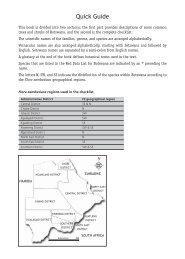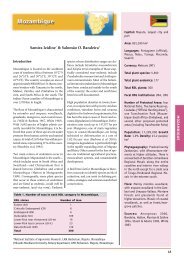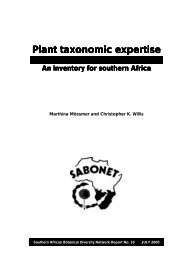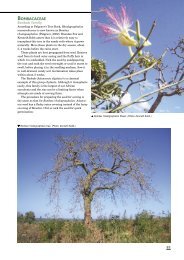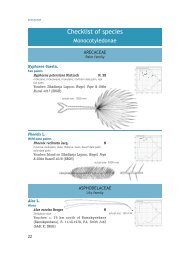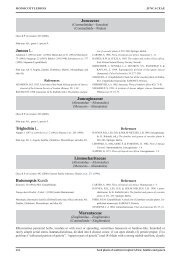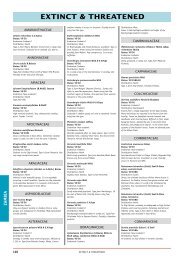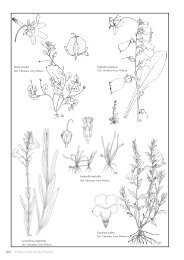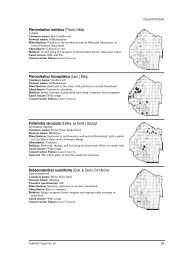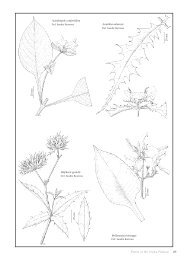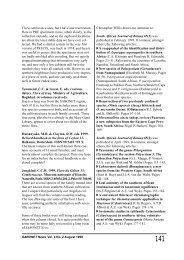Download this file - SANBI
Download this file - SANBI
Download this file - SANBI
Create successful ePaper yourself
Turn your PDF publications into a flip-book with our unique Google optimized e-Paper software.
Using the checklist<br />
Arrangement<br />
The arrangement of the checklist is alphabetical by family followed by genus, grouped under Pteridophyta,<br />
Gymnosperms, Monocotyledons and Dicotyledons. All species and synonyms are arranged alphabetically<br />
under genus. Numbering of monocotyledon and dicotyledon genera follows the Englerian system of De<br />
Dalla Torre & Harms (1958), as used by SRGH, with modifications where necessary. This is mostly in<br />
agreement with that given in Arnold & De Wet (1993). However, although arrangement and numbering of<br />
Pteridophyta follows that of the PRECIS system (NBI, Pretoria), nomenclature follows that of Roux (2001).<br />
Author citation abbreviations follow those given in Brummitt & Powell (1992), while authorities for genera<br />
follow Brummitt (1992).<br />
Taxonomy<br />
Accepted names are in bold print while synonyms or previously-used names are in italics.<br />
Flora zambesiaca and Kirkia volumes were used as the major taxonomic references, with nomenclature<br />
checked and clarified using Lebrun & Stork (1991–1997). Where appropriate recent publications are<br />
available, however, these were used instead, including the revised Trees of southern Africa (Coates Palgrave<br />
2002). Hence nomenclature is not necessarily the same as that used by the National Herbarium in Pretoria<br />
or other regional herbaria. Some groups have been reviewed by specialists (Commelinaceae—Bob Faden;<br />
Dracaenaceae—Ratti Takawira; Liliaceae sensu lato—Shakkie Kativu; Orchidaceae—Werner Fibeck;<br />
Poacaeae—Lyn Fish; Asclepiadaceae—David Goyder; Lamiaceae and Verbenaceae—Alan Paton;<br />
Moraceae—John Burrows).<br />
Synonyms<br />
The synonyms for many families are very inadequately treated. It is hoped to add other older or inaccurately<br />
applied names in a later edition. Only synonyms that are recent or known to appear in a number of publications<br />
in use in Zimbabwe, or where the type is from Zimbabwe, are included. They are listed alphabetically under<br />
the appropriate genus. The currently used name follows the equals sign (=), and only refers to usage in<br />
Zimbabwe. Distribution information is included under the current name.<br />
Aliens<br />
All species known or suspected to be fully naturalised in Zimbabwe are included in the list. They are<br />
preceded by an asterisk (*). Species only known from planted or garden specimens were not included.<br />
Distribution<br />
The letters N, W, C, E, and S, following each listed taxon, indicate the known distribution of species within<br />
Zimbabwe as reflected by specimens in SRGH or cited in the literature. The map on page 4 shows these<br />
geographical divisions. Although additional confirmed records are included where available, geographical<br />
coverage is likely to be incomplete. Where the distribution is unknown, we have inserted Distr.? after the<br />
taxon name.<br />
SABONET Report No. 33 3


